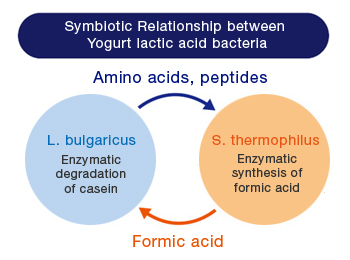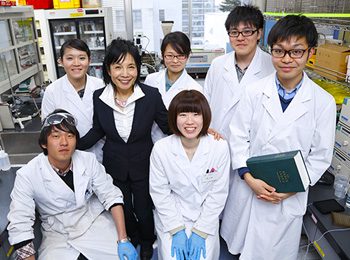

Lactic acid bacteria—a research theme both ancient and new
Lactic acid bacteria are not only the most familiar types of bacteria for us, they are also extremely important microorganisms from an industrial standpoint. My research focuses specifically on the workings and genetics of lactic acid bacteria that make yogurt using milk as the main ingredient.Lactic acid bacteria is a general term of bacteria that metabolize sugar to create energy, generating great quantities of lactic acid. Unique characteristics of these bacteria include production of large quantities of lactic acid from sugar, a preference for anaerobic conditions and successful growth despite weak acidic environment. Human beings have learned through experience about the workings of lactic acid bacteria and have utilized them in yogurt, cheese, pickles, miso, soy sauce, sake, wine and various other fermented foods and beverages. Lactic acid bacteria have been chosen on many occasions to produce more delicious products that keep for longer periods of time, and continuous innovation in the development of these products has made them into important elements of people’s cultures in various regions.
Research and discovery in the field of lactic acid bacteria is the process of reexamining from a scientific perspective the ways in which human beings have come to use these bacteria. In this sense, lactic acid bacteria research consists of both ancient and contemporary values, making it an incredibly attractive pursuit.
Acceleration of genetic research via genomic information
Modern genetic research methods for lactic acid bacteria were first established in the 1970s, and when genome sequencing efforts were begun in the latter half of the 1990s a wide variety of genetic constructions from different species of lactic acid bacteria were identified, providing vast amounts of information related to the characteristics and evolution of these bacteria. What is called “Omics” analyses using genome information can be applied to comprehensively analyze an entire bacterium, and various approaches are utilized including proteomic analysis (of all proteins), metabolomic analysis (of all metabolites), and transcriptomic analysis using DNA microarrays (of all transcripts), among others. I worked for a food company until 2011, and used mainly microarray analysis in my research. The lactic acid bacteria I researched there have approximately 2,000 genes. Microarray analysis, during which all of those genes are placed atop a glass slide, provides a means of easily observing which genes (gene clusters) are transcribed and become proteins to facilitate adaptation to environmental conditions (for example, gastric acid or bile acid conditions), making it an indispensable approach in genetic research.
By observing this mechanism in which functionality is maintained by other genes even if a single gene is made inactive, we were able to see just how important acid resistance was for this lactic acid bacterium, providing a clearer picture overall of how they utilize various methods and strategies to survive.
Two bacterial species that compensate for the other’s weaknesses
The traditional yogurt is made by two species of lactic acid bacteria: Lactobacillus delbrueckii subsp. bulgaricus (L. bulgaricus; a rod-shaped bacterium) and Streptococcus thermophilus (S. thermophilus, a coccal bacterium). These two bacteria have a long history of living together in milk and they complement the other’s metabolic products and mutually supply each other through a symbiotic relationship. I am currently interested and involved in research on the workings of the symbiotic relationship between these two bacteria.It would take eight hours for one of these species to produce sufficient levels of lactic acid to make yogurt, but by working together they are able to accomplish it in about three hours—less than half the time. Proteases of L. bulgaricus break down casein in milk and supply amino acids and peptides necessary for S. thermophilus to grow, while S. thermophilus supplies formic acid necessary for L. bulgaricus to grow. In other words, these two bacteria used for yogurt production exchange materials and supplement requirements for good growth that the other bacterium cannot afford by oneself, which creates an environment suitable for habitation.

These two lactic acid bacteria mutually provide each other with metabolic products and also exchange other substances
However, this reciprocal relationship is not very effective when some other strains of these species are used. Locating good and bad strains combinations and clarifying the underlying mechanisms therein is a very difficult thing to do at a company, which is why universities should handle the fundamental genetics research necessary to explain such mechanisms.
The importance of possessing correct knowledge about lactic acid bacteria
It seems to me that the word “probiotics” has become more and more common in the past ten years. This word refers to microorganisms that are beneficial to the human body as well as food products containing such microorganisms. Each of our intestines contains approximately 100 trillion bacteria of hundreds of different species, which measures out to about 1 kg (2.2 lbs) in terms of weight. A human being’s total cell count is around 60 trillion, meaning that there are more microorganisms in the intestine than cells in the body. Yogurt is unique in the vast amounts of live bacteria it helps our body to take in—a single spoonful contains 50 million lactic acid bacteria. Lactic acid bacteria cells, live or dead, enter through the mouth and proceed into the intestine (which plays a central role in the immune system) to help maintain the enteral environment, strengthen and stimulate immunity, activity, prevent allergies and perform various other functions.
Professor Sasaki joined Meiji University in 2012. She says that her discussions with students and opportunities to learn together with them have given her strength.
Profile
Associate Professor, Department of Agricultural Chemistry, School of AgricultureSasaki Yasuko worked as an assistant professor in The University of Tokyo’s Faculty of Agriculture and as a researcher at the Meiji Dairies Corporation Food Science Research Center before becoming an associate professor at Meiji University in 2012. She has a Ph.D. in Agriculture from The University of Tokyo.
Applied microbiology, exploration of the symbiotic mechanisms of lactic acid bacteria in yogurt and the effects of dissolved oxygen on yogurt fermentation, construction of genetic manipulation methods for lactic acid bacteria utilizing conjugal plasmid transfer
Nyusankin to Bifizusu-kin no Saiensu (“The Science of Lactic acid bacteria and Bifidobacteria,” joint authorship, Kyoto University Press), Chonai Furoora to Kurosutooku (“Molecular Cross Talk: Intestinal Microbiota and the Host,” joint authorship, Gakkai Publishing Center), Mirai o Tsukuru Baio: Sakezukuri kara Saisei-iryo Made 60-wa (“Bio for the Future: 60 Stories from Sake-brewing to Regenerative Medicine,” joint authorship, Gakushin Publishing), others









